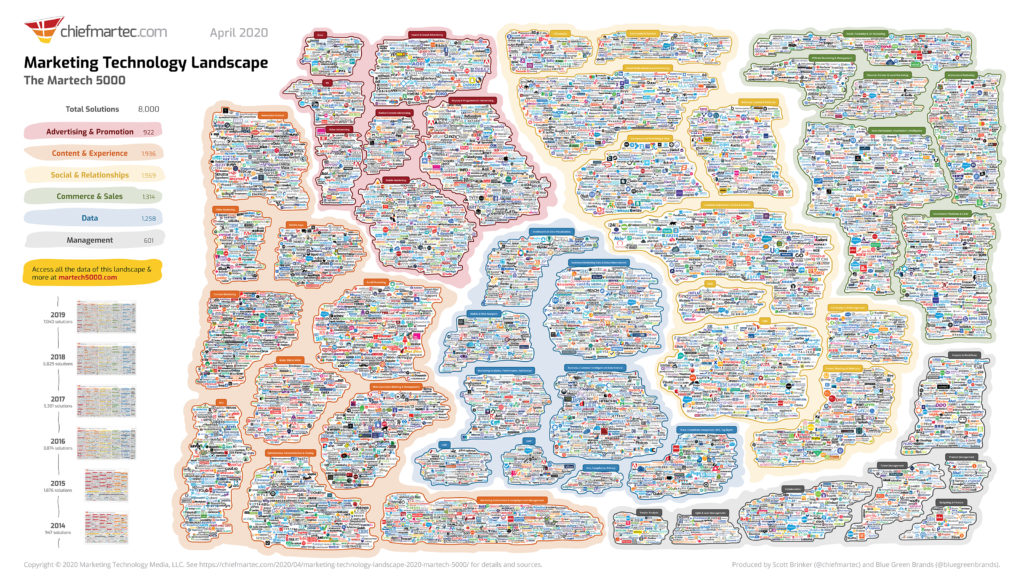What is Marketing Technology (MarTech) - Your Getting Started Guide

Table of Contents
Marketing technology or MarTech is software used by the marketing department to achieve marketing objectives. MarTech helps with automating marketing processes, enhancing marketing effectiveness, personalization, data collection and processing, and campaign delivery. In short, MarTech empowers marketers to execute smarter and scalable campaigns with a better return on investment.
A practical example of MarTech
Imagine that an Email Marketing Specialist is using email marketing software to automatically send subscribers an email when a new blog post has been published. The software will automatically scrape the blog title and featured image and proceeds by scheduling the email at a predetermined timeslot.
In the above example, the email marketing software is considered Marketing Technology, or MarTech.
What is a MarTech stack?
A Marketing Technology (MarTech) stack is the collection of all the software that a marketing team is using to achieve their marketing objectives.
A MarTech Stack often contains software in the following categories:
- Email marketing software, such as GetResponse.
- Marketing automation software, such as Marketo.
- Search Engine Optimization (SEO) software, such as Semrush.
- Customer Relationship Management (CRM), such as Salesforce.
- Social media management software, such as Hootsuite.
- Conversational relationship software, such as Intercom.
As you can imagine, it can become challenging to get the most value out of all of these tools. In fact, Gartner’s research shows that 68% of MarTech leaders face challenges using their MarTech stack full breadth of capabilities.
Why is MarTech important?
A carefully crafted MarTech stack allows businesses to reach their buyers more effectively, with a better message, and with a higher conversion rate. This results in businesses achieving a greater return on their marketing investments.
The importance of MarTech investment is backed up by research from Gartner. MarTech currently accounts for 26.2% of the total marketing budget. This is higher than in-house labor investments which account for 24.5% of the marketing budget. The investment in MarTech is expected to increase year over year.
All in all, MarTech is important for businesses because of the following reasons:
- Ability to make data-based decisions;
- Automate marketing work and minimize human errors;
- Create scalable marketing campaigns;
- Improve the conversion rates through personalization;
- Reach your buyers through tailored messages;
- Achieve a better return on marketing spend.
Why do you need Marketing Technology?
Businesses need marketing technology as the markets are becoming more competitive by the day. Companies that have solid MarTech strategies will be able to outcompete competitors with less effective MarTech strategies. This is due to the achieved scalability and ROI improvements that a solid MarTech strategy achieves. In short, without MarTech, companies will struggle to compete in today’s market.
Earlier in this article, I referenced Gartner’s research that indicates that companies are spending 26.2% of their marketing budget on MarTech. If that 26.2% was spent on in-house marketing staff instead, businesses would be unlikely to achieve the same ROI and marketing effectiveness as companies that spend that 26.2% on MarTech.
What is a MarTech landscape?
The MarTech landscape is simply a collection of all the available marketing technology software in today’s market.
Today, there are over 8000 companies that have developed marketing technology.
In 2020, Scott Brinker from ChiefMartec has mapped out the landscape to give you an impression of what the landscape looks like.

What is a MarTech strategy?
A MarTech strategy defines how your business will use marketing technology to achieve its main objectives. The strategy will define which software you will use and the desired outcomes of using said software. Additionally, it will focus on adoption, people, and review.
There are some core components to a marketing strategy:
- First, you need to define the top-level objectives of your business or marketing department.
- Second, you need to evaluate the current state of the business and identify the gaps that MarTech can fill.
- Third, you need evangelists who will ensure that the marketing technology is adopted within the company.
- Fourth, you need a training program and talent to work with the marketing technology
- Fifth, you need a review cadence to make sure that the selected MarTech has achieved its desired outcomes.
- Sixth, you need an innovation program to ensure you’re staying ahead of the curve with your MarTech.
Needless to say, these are the basic components of a marketing strategy. Every business needs a bespoke marketing technology strategy as no two businesses are the same.
How can I compare MarTech?
With over 8000 companies supplying MarTech, it can be overwhelming to select the right technology for your business. You can compare MarTech by first understanding the general category of the MarTech that you’re seeking.
Let’s say you’ve identified a gap in your SEO efforts and realized that you need SEO software to achieve your business objectives. This narrows your search down quite significantly.
Here on Markletic, we write reviews about MarTech, but also actionable how-to’s, use cases, and evaluation guides. For example, here you will find our SEO Software reviews.
We also recommend looking on websites such as G2 for peer reviews.
What are common categories of MarTech?
Considering that there are more than 8000 MarTech companies in the market, it’s clear that the list of categories is significant as well. When composing your MarTech strategy, there are a few categories that are often included. Below, you will find the top 10 MarTech categories.
1. Email Marketing Software
Email marketing software helps marketers to send (automated) emails to their stakeholders. Most email marketing software also allows customers to build landing pages and forms. Email marketing software can be used to deliver messages to your subscribers and it often integrates with e-commerce platforms as well.
Learn more about email marketing software here on Markletic.
Some of our email marketing software reviews:
- Mailerlite Review: Pros, Cons, Features, Pricing
- Getresponse Review: Email Marketing for SMBs
- Aweber Review: Email Marketing for Small Businesses
Email Marketing Software how-tos:
2. SEO Software
Search engine optimization (SEO) software helps marketers to improve the rankings of their websites on search engines. These tools collect data, provide insights, and give SEO recommendations to Search Engine Specialists. Through SEO software, businesses can improve their online visibility.
Learn more about SEO software here on Markletic.
Some of our SEO software reviews:
3. CRM Software
Customer Relationship Management (CRM) software helps businesses to track and manage people’s interactions. A CRM platform acts as a system of records and it often integrates with marketing automation platforms such as Marketo. This allows a CRM to also display the campaign history of customers as well as web traffic history.
Businesses use CRMs to record interactions, contact information, campaign history, transaction, and opportunity information. It’s usually the central place for businesses to store customer information.
Examples of CRM software are Salesforce and Hubspot CRM.
4. Event Management Software
Event management software is used by marketers to manage events and conferences. The software allows businesses to handle payment, attendee registration, audience communication, and more.
Recently, a lot of virtual event platforms entered the market as well. These platforms allow you to host large virtual conferences, a topic we’ve extensively discussed on Markletic.
Some of our virtual event platform reviews:
- Filo Review: Virtual Event Platform for Collaboration
- Detailed Airmeet Review: Features, Pros & Cons, and Alternatives
5. Marketing Automation Software
Marketing automation software streamlines workflows, automates marketing tasks, helps with measuring the impact of campaigns, and it tracks what users are doing on your website. Marketing automation software acts as a central hub for marketing information and interaction with your stakeholders. The software integrates with other crucial MarTech such as social media management, CRMs, email marketing software, and content management systems. It’s the centerpiece of your MarTech stack.
Marketing automation software also handles lead management and scoring. This allows your business to prioritize which leads to follow-up on first. In addition, it contains advanced analytical tools to measure campaign performance.
Many email marketing software providers also provide a level of marketing automation such as Getresponse and Mailerlite.
Other examples of marketing automation software include Marketo, ActiveCampaign, and Hubspot Marketing Hub.
6. Social Media Management Software
Social media marketing software lets you manage, schedule, and publish social media posts. These tools will also give you statistics on the performance of your posts so that you can tailor your strategy accordingly.
While some social media platforms stop there, others also allow you to interact with your audience and provide a dashboard to manage incoming messages from multiple social media platforms. This is especially useful for larger businesses with an active social media following.
Social media software also enables you to monitor hashtags and work with influencers.
Examples of social media management tools include Hootsuite, Buffer, and Sproutsocial.
7. Content Marketing Software
Content marketing software helps marketers to create content in optimized and accelerated ways. It will help with SEO writing, identifying keywords, but also using artificial intelligence (AI) to accelerate content production.
Technically, design software also falls under content marketing software. However, most people refer to content marketing software when it assists in the creation of text-based content.
Another category within content marketing software is content curation software. This essentially helps you to collect other pieces of content that you can use for inspiration.
Semrush is an example of content marketing software that helps with SEO writing.
8. Conversational Marketing Software
Conversational marketing software is essentially a chatbot on the website of a business as a way to interact with your audience. The software can answer frequently asked questions, but it also helps with sales qualification and providing customer support.
An example of conversational marketing software is Drift or Intercom.
9. Public Relations Software
Public relations software helps marketers with the targeting of media and influencers. You also have software that helps with media monitoring. This helps PR professionals to track brand mentions in other publications.
Most public relations software also comes with analytical features that enable PR professionals to better measure the impact of PR efforts - which is often quite difficult to achieve.
A big part of public relations is to distribute press releases at the right time without the risk of information leaking. Public relations software also streamlines the distribution of press releases.
Tools such as Semrush and Meltwater can handle media monitoring and targeting.
10. Demand Generation Software
Demand generation software allows companies to drive brand awareness and generate leads for the business. It helps sales organizations with the automation of outbound marketing, and it helps marketing departments to target their audience with laser precision.
Demand generation software is a broad category that houses sub-categories such as account-based marketing software, intent-based marketing software, and loyalty management software.
Lusha, Zoominfo, MRP, and Demandbase are popular examples of demand generation software.
There you have it, my top 10 list of MarTech categories that will help you get started with researching the marketing technology landscape.
What is the difference between MarTech and AdTech?
Advertising Technology (AdTech) is a sub-category of Marketing Technology (MarTech). While MarTech refers to the entire marketing technology stack, AdTech simply refers to the toolset that companies use for paid media advertising.
AdTech tools help businesses to:
- Sell their ad inventory automatically through a Supply-side platform (SSP);
- Buy ad inventory on other platforms through a Demand-side platform (DSP);
- Track and analyze the performance of advertising campaigns;
- Conduct competitive advertising analysis to understand what ads competitors are running.
In today’s day and age, the selling and buying of advertising space are practically fully automated. Technology enables companies to place bids on advertising space and allows publishers to automatically accept the highest bid. This is also known as programmatic advertising.
We have a detailed article on how programmatic advertising works here.
What are the essentials of a MarTech Implementation
The aforementioned Gartner research shows that 68% of MarTech leaders are not getting the maximum value out of their MarTech stack. This is because some essential implementation components are not optimized.
Below we will briefly summarize the core implementation components.
1. Objectives
Before making a purchase decision on MarTech, you need to fully understand what the desired outcome of your prospective MarTech is. Create a baseline and document this somewhere. This will help you during your MarTech review to see if you are achieving the objectives.
2. Adoption
Create a solid adoption plan for your marketing technology. You need to have champions who will be advocates for your MarTech. Without adoption, you are wasting money on license fees and opportunity costs.
3. Training
You need to work together with the MarTech vendor to create a solid training program for your employees. These sessions need to be interactive and available on-demand. Also, think about training programs for the new hires.
4. People
You need skilled people to work with MarTech. When adopting new marketing technology, it might mean that you have to hire new people with a foundational skill set of MarTech. These people can also act as champions and educate existing employees.
5. Integration
MarTech should always integrate with your other systems and IT landscape. The majority of your marketing technology stack needs to be able to communicate with each other through APIs.
If your core MarTech software is not communicating with each other, it will cause frustration, inefficiencies, and human error.
6. Optimization
MarTech is always evolving and the vendors are constantly delivering new innovative features. Based on new features and new knowledge, you should always be looking to optimize your MarTech and its implementation.
7. Review
You need quarterly review sessions to understand if the acquired MarTech is achieving its objectives; if the level of adoption is at the desired level; and if there are improvements to be made. Make it a priority to conduct review sessions.
How do I learn MarTech?
Most MarTech companies have an academy. These academies are full of useful resources and you can often earn certificates by completing their educational program. Another useful method is to watch YouTube videos.
However, the famous saying stays true: practice makes perfect. You will learn MarTech the quickest by just diving in and learning through experience.
Naturally, you can also find loads of helpful articles here on Markletic. On Markletic, we provide reviews and how-to articles of MarTech. Here you will also be able to learn about new features.
Share this article

